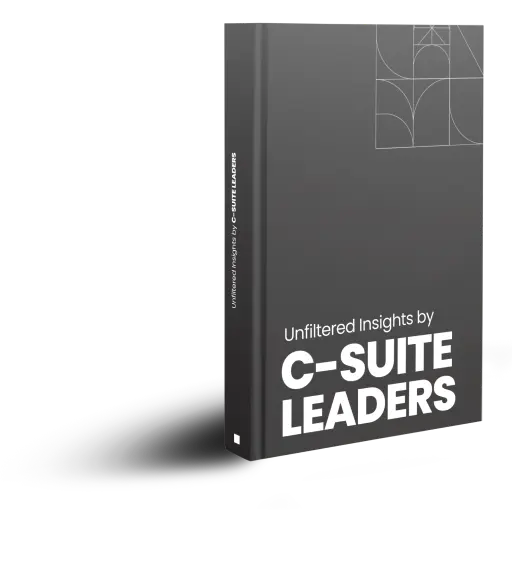
Strategic Shifts in B2B Marketing: CMOs, It’s Time to Talk AI
In this article
Introduction
What’s Changing for CMOs?

Strategic Shift: From Guesswork to Data-Driven Decisions
Traditional Marketing:
AI-Driven Marketing:
What’s Changing for CMOs?
-
Faster Decision-Making: Through AI, marketing leaders and CMOs can adjust their strategies instantly using real-time performance data to eliminate delays in transforming knowledge into actions.
-
Greater Precision: AI-driven marketing insights identify niche audience segments for better outreach.
-
Competitive Advantage: CMOs can use the insights to gain the ability of recognizing market adaptations, which in turn aids in maintaining their competitive position.
Efficiency Boost: Doing More with Less
Traditional Marketing:
AI-Driven Marketing:
What’s Changing for CMOs?
-
Operational Efficiency: AI-driven automation isn’t just about efficiency, it’s about enabling CMOs to shift their teams from execution to strategy. Automation takes care of repetitive tasks, like lead scoring, email workflows, and reporting, so teams can focus on the bigger picture. Instead of getting stuck in execution mode, marketers have more time to think creatively, refine their strategies, and build campaigns that actually move the needle.
-
Cost Reduction: AI improves finance management results through automated channel performance analysis, which leads to optimized spending allocation.
-
Enhanced Team Productivity: Automated insights and content creation empower smaller teams to deliver high-impact results with fewer resources.
Personalization at Scale: Engaging the Right Audience with the Right Message
Traditional Marketing:
AI-Driven Marketing:
What’s Changing for CMOs?
-
Hyper-Targeting: The use of AI facilitates large-scale personalized marketing because it provides unique content recommendations to each decision-maker.
-
Higher Engagement: The delivery of personalized content leads prospects to become more engaged and interact with higher significance.
-
Improved Customer Retention: The deployment of AI-powered personalization services leads to improved customer relationships because interactions become more beneficial while being more specially crafted.
The Currency of Connection Innovation Built on Trust
What’s Changing for CMOs?
-
Data Transparency: CMO’s can utilize AI-driven analytics, which build data-supported arguments for their decisions to earn trust from both internal teams and client bases.
-
Thought Leadership: The insights generated by AI can help brands to generate focused, relevant content, which establishes their authority in their industries.
-
Customer Confidence: Relevant and timely content delivery produces stronger buyer trust and better customer retention results.
Now the question is – Which Strategy is Better?
Advantages of AI-Driven Marketing:
- Processes vast datasets with unmatched speed and accuracy
- Delivers precise customer behavior predictions
- Enables personalized engagement at scale
Traditional Marketing’s Enduring Value:
- Builds authentic brand relationships
- Creates emotionally resonant content
- Drives high-touch sales interactions
The Optimal Approach: Strategic Integration
- Enhanced campaign efficiency and ROI
- Deeper customer and AI-driven marketing insights
- Stronger emotional connections at scale
AI Marketing + Traditional Marketing: A Balanced Approach for Future Success
What’s Holding Your Team Back from Engaging the Right Leads?
Be a part of 1000+ successful clients that have chosen UnboundB2B for growth.
Discover more resources

Successful B2B Lead Generation requires generating Marketing Qualified Leads. In this article, we have discussed how to identify MQLs and 10 practical tips to generate more MQLs. These tips cover essential strategies from optimizing your sales funnel to leveraging engaging videos and interactive content. You'll learn about the importance of strong calls-to-action, utilizing chatbots, and implementing Account-Based Marketing. We'll explore how a Customer Data Platform can improve your targeting and lead-generation efforts. By implementing these strategies, you can significantly improve your MQL generation and boost your B2B growth.

Struggling to grow your B2B business? The key lies in understanding the difference between demand generation and demand capture. While one creates awareness and interest, the other converts that interest into tangible results. But which strategy should you focus on for sustainable growth? This blog post has the answer. Plus, you can find practical strategies for both demand generation and demand capture. Read on to learn how you can scale your B2B business.

Demand for SaaS products and services has increased significantly in recent years. By making cloud-based software solutions more accessible, SaaS companies bring technology closer to modern businesses. The increased demand has resulted in a highly competitive SaaS environment. One effective strategy companies can use to stay ahead of the competition is SaaS advertising. Read on to discover how ad platforms facilitate SaaS advertising and find out which advertising platforms your company can leverage to succeed in sales.


 Faster Decision-Making: Through AI, marketing leaders and CMOs can adjust their strategies instantly using real-time performance data to eliminate delays in transforming knowledge into actions.
Faster Decision-Making: Through AI, marketing leaders and CMOs can adjust their strategies instantly using real-time performance data to eliminate delays in transforming knowledge into actions. Greater Precision:
Greater Precision:  Competitive Advantage: CMOs can use the insights to gain the ability of recognizing market adaptations, which in turn aids in maintaining their competitive position.
Competitive Advantage: CMOs can use the insights to gain the ability of recognizing market adaptations, which in turn aids in maintaining their competitive position. Operational Efficiency: AI-driven automation isn’t just about efficiency, it’s about enabling CMOs to shift their teams from execution to strategy. Automation takes care of repetitive tasks, like
Operational Efficiency: AI-driven automation isn’t just about efficiency, it’s about enabling CMOs to shift their teams from execution to strategy. Automation takes care of repetitive tasks, like  Cost Reduction: AI improves finance management results through automated channel performance analysis, which leads to optimized spending allocation.
Cost Reduction: AI improves finance management results through automated channel performance analysis, which leads to optimized spending allocation. Enhanced Team Productivity: Automated insights and content creation empower smaller teams to deliver high-impact results with fewer resources.
Enhanced Team Productivity: Automated insights and content creation empower smaller teams to deliver high-impact results with fewer resources. Hyper-Targeting: The use of AI facilitates large-scale personalized marketing because it provides unique content recommendations to each decision-maker.
Hyper-Targeting: The use of AI facilitates large-scale personalized marketing because it provides unique content recommendations to each decision-maker. Higher Engagement: The delivery of personalized content leads prospects to become more engaged and interact with higher significance.
Higher Engagement: The delivery of personalized content leads prospects to become more engaged and interact with higher significance. Improved Customer Retention: The deployment of
Improved Customer Retention: The deployment of  Data Transparency: CMO’s can utilize AI-driven analytics, which build data-supported arguments for their decisions to earn trust from both internal teams and client bases.
Data Transparency: CMO’s can utilize AI-driven analytics, which build data-supported arguments for their decisions to earn trust from both internal teams and client bases. Thought Leadership: The insights generated by AI can help brands to generate focused, relevant content, which establishes their authority in their industries.
Thought Leadership: The insights generated by AI can help brands to generate focused, relevant content, which establishes their authority in their industries. Customer Confidence: Relevant and timely content delivery produces stronger buyer trust and better
Customer Confidence: Relevant and timely content delivery produces stronger buyer trust and better 




